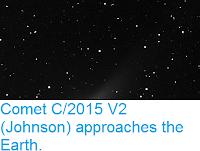Asteroid 2017 KHW31 passed by the Earth at a distance of 471 400 km
(1.29 times the average distance between the Earth and the Moon, 0.32%
of
the average distance between the Earth and the Sun), slightly before 7.10 am GMT
on Wednesday 31 May 2017. There was no danger of the asteroid
hitting us, though had it done so it would have presented no threat.
2017 KW31 has an estimated equivalent diameter of 9-30 m (i.e. it is
estimated that a spherical object with the same volume would be 9-30 m
in diameter), and an object of this size would be expected to explode in
an airburst (an explosion caused by superheating from friction with the
Earth's atmosphere, which is greater than that caused by simply
falling, due to the orbital momentum of the asteroid) in the atmosphere
between 33 and 16 km above the ground, with only fragmentary material
reaching the Earth's surface.
The calculated orbit of 2017 KW31. Minor Planet Center.
2017 KW31 was discovered on 28 May 2017 (Three days before its closest approach to the Earth) by the University of Arizona's Catalina Sky Survey,
which is located in the Catalina Mountains north of Tucson. The
designation 2017 KW31 implies that it was the 797th asteroid (asteroid W31)
discovered in the second half of May 2017 (period 2017 K).
2017 KW31 has an 601 day orbital period and an eccentric orbit
tilted at an angle of 5.91° to the plane of the Solar System, which
takes it from 0.85 AU from the Sun (i.e. 85% of he average distance at
which the Earth orbits the Sun)
to 1.93 AU from the Sun (i.e. 193% of
the
average distance at which the Earth orbits the Sun, considerably over the distance at which the planet Mars orbits the Sun).
It is therefore classed as an
Apollo Group Asteroid (an asteroid that is on average further from the
Sun than the Earth, but which does get closer). This means that close
encounters between the asteroid and Earth are common, with the
last having occurred in November 2012 and the next predicted for May 2022.
2017 KW31 also
has frequent close encounters with the planets Venus, which it is calculated to have last passed in July 1988 is
next predicted to
pass in August 2063, and Mars which it
is next predicted to pass in June 2126. Asteroids
which make close passes to multiple planets are considered to be in
unstable orbits, and are often eventually knocked out of these orbits by
these encounters, either being knocked onto a new, more stable orbit,
dropped into the Sun, knocked out of the Solar System or occasionally
colliding with a planet.
See also...
Follow Sciency Thoughts on Facebook.







